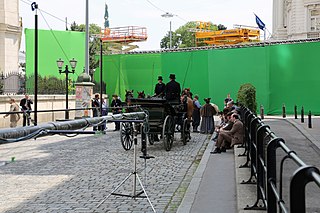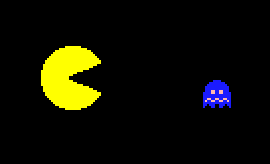Related Research Articles

Animation is a method in which figures are manipulated to appear as moving images. In traditional animation, images are drawn or painted by hand on transparent celluloid sheets to be photographed and exhibited on film. Today, most animations are made with computer-generated imagery (CGI). Computer animation can be very detailed 3D animation, while 2D computer animation can be used for stylistic reasons, low bandwidth, or faster real-time renderings. Other common animation methods apply a stop motion technique to two and three-dimensional objects like paper cutouts, puppets, or clay figures.
Parallax scrolling is a technique in computer graphics where background images move past the camera more slowly than foreground images, creating an illusion of depth in a 2D scene of distance. The technique grew out of the multiplane camera technique used in traditional animation since the 1930s.

Special effects are illusions or visual tricks used in the theatre, film, television, video game, and simulator industries to simulate the imagined events in a story or virtual world.

A storyboard is a graphic organizer that consists of illustrations or images displayed in sequence for the purpose of pre-visualising a motion picture, animation, motion graphic or interactive media sequence. The storyboarding process, in the form it is known today, was developed at Walt Disney Productions during the early 1930s, after several years of similar processes being in use at Walt Disney and other animation studios.
Visual effects is the process by which imagery is created or manipulated outside the context of a live action shot in filmmaking and video production. The integration of live action footage and other live action footage or CG elements to create realistic imagery is called VFX.

Traditional animation is an animation technique in which each frame is drawn by hand. The technique was the dominant form of animation in cinema until the advent of computer animation.
2.5D perspective refers to one of two things:

Skeletal animation or rigging is a technique in computer animation in which a character is represented in two parts: a surface representation used to draw the character and a hierarchical set of interconnected parts, a virtual armature used to animate the mesh. While this technique is often used to animate humans and other organic figures, it only serves to make the animation process more intuitive, and the same technique can be used to control the deformation of any object—such as a door, a spoon, a building, or a galaxy. When the animated object is more general than, for example, a humanoid character, the set of "bones" may not be hierarchical or interconnected, but simply represent a higher-level description of the motion of the part of mesh it is influencing.
In first-person shooter games, rocket jumping is the technique of using the explosion of an explosive weapon, most often a rocket launcher, to launch the shooter. The aim of this technique is to reach heights and distances that standard character movement cannot achieve. Although the origin of rocket jumping is unclear, its usage was popularized by Quake.
Emergent gameplay refers to complex situations in video games, board games, or table top role-playing games that emerge from the interaction of relatively simple game mechanics.
Mattes are used in photography and special effects filmmaking to combine two or more image elements into a single, final image. Usually, mattes are used to combine a foreground image with a background image. In this case, the matte is the background painting. In film and stage, mattes can be physically huge sections of painted canvas, portraying large scenic expanses of landscapes.
Computer facial animation is primarily an area of computer graphics that encapsulates methods and techniques for generating and animating images or models of a character face. The character can be a human, a humanoid, an animal, a legendary creature or character, etc. Due to its subject and output type, it is also related to many other scientific and artistic fields from psychology to traditional animation. The importance of human faces in verbal and non-verbal communication and advances in computer graphics hardware and software have caused considerable scientific, technological, and artistic interests in computer facial animation.
Previsualization is the visualizing of complex scenes in a movie before filming. It is also a concept in still photography. Previsualization is used to describe techniques such as storyboarding, either in the form of charcoal sketches or in digital technology, in the planning and conceptualization of movie scenes.
DeFRaG is a free software modification for id Software's first-person shooter computer game Quake III Arena (Q3A). The mod is dedicated to player movements and trickjumping. It aims at providing a platform for self-training, competition, online tricking, machinima making, and trickjumping. Hence it constitutes an exception among other Q3A mods.

Wild Guns is a 1994 space western shooting gallery video game developed by Natsume for the Super Nintendo Entertainment System. Set in the Wild West with steampunk and sci-fi influences, the story follows Annie and her bounty hunter Clint, seeking revenge for the death of her family. The player controls either Annie or Clint sidestepping and jumping in the foreground while shooting down enemy robots in the background and dodging enemy bullets. These gameplay mechanics combine elements from third-person shooters and light gun games.
Strafing is the act of moving sideways in a video game relative to the player's forward direction. Strafing allows a player to keep the camera focused on a target such as an enemy, while moving in a different direction.

Source Filmmaker is a 3D computer graphics software toolset used for creating animated films, utilizing the Source game engine. The tool, created by Valve, was used to create over 50 animated shorts for its Source games, including Team Fortress 2, the Left 4 Dead series, and Half-Life 2. On June 27, 2012, Valve released a free open beta version of the SFM to the gaming community via its Steam service.
This list includes terms used in video games and the video game industry, as well as slang used by players.

A cutscene or event scene is a sequence in a video game that is not interactive, breaking up the gameplay. Such scenes could be used to show conversations between characters, set the mood, reward the player, introduce newer models and gameplay elements, show the effects of a player's actions, create emotional connections, improve pacing or foreshadow future events.
An arena shooter is a subgenre of shooter games that cover both the first-person shooter and third-person shooter genres. These games emphasize fast paced movement in enclosed areas with a heavy emphasis on quick reaction time.
References
- ↑ "Team Fortress 2: Technology". PlanetFortress. Archived from the original on June 1, 2007. Retrieved April 5, 2007.